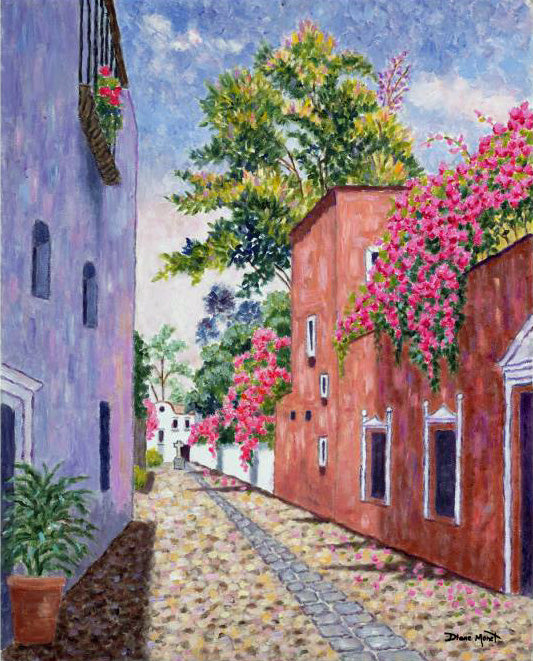Alexanre Monet -- Diane Monet's grandfather -- moved to the United States from Paris in 1887 at the age of 24, working as a chef and sign-painter. He was always proud to note that he was a relative of Claude Monet, the artist. Diane Monet grew up in the New York area and went on to graduate from New York University with an honors degree in international marketing. She also studied at the National University of Mexico. After graduation, she was responsible for marketing consumer products at Avon, Brisol-Meyers and PepsiCo. However, by 1986, her leisure time painting was no longer sufficient, so her late husband Gary encouraged her to devote full time to artistic endeavors. Artistically, Diane Monet is self-taught. By painting almost every day, she is always seeking to improve her craft.
Diane Monet has lived in the New York area most of her life, but with a very strong wanderlust. Her father said that she "lives in a fantasy world" and a close friend said that she was "born to play". She travels extensively and feels very much at home in Europe and in Mexico. It is this sense if fantasy, play and joyfulness that she tries to communicate in her work. During her travels - often in France and Italy - Ms. Monet searches for settings that inspire her, sketching and photographing gardens, landscapes, and other vistas that have the potential to bring joy and beauty to her work. Returning home to her studio in New York, she then chooses those subjects that she believes will be most enjoyed by others as well, plans her artistic strategy, and then adds her impressionistic interpretation, not to mention many meticulously applied layers of oil on canvas, including some with a fine eyeliner brush.
With Diane Monet's impressionist style, her work has been especially popular in Japan. In addition to personal appearances, her one-person shows have elicited several invitations to appear on NHK Television and Sendai Television. Her work evokes unusually strong emotional responses there. For example, one couple told her that, after purchasing her painting the previous year, their home is happier and their relationship has markedly improved. Many infirm people have remarked that her paintings give them strength and happiness each day. Tears of joy have streamed down the face of many buyers while purchasing their Monet. Needless to say, Ms. Monet herself is deeply moved by these reactions.
Throughout Dianne Monet's life she has admired the art of Claude Monet, Camille Pissarro, Childe Hassam, J.M.W. Turner, and the drawings of Peter Paul Rubens. Her own work is done from a cluttered, two-window, corner studio that was designed and built by her husband. Overflowing with paints, brushes, canvases and color swatches, it is expressly off limits to visitors. All of her work is done in oil on canvas, and the look that she desires requires the application of many layers, so her work is quite time-intensive. But mostly her work is appreciated for its joyous mood and subjects. As she says. "It is my wish to give people sun-filled escapes from the pressures and stresses of the world, to offer serene views of gardens, fields and resort areas so that my paintings provide little vacations of joy and hope." She revels in colors and chooses settings abounding in vivid shades. Then she adds her own touch.
Diane Monet can turn a simple shadow into a kaleidoscope, a body of water into a montage, a sky into an eternal field of cotton, a tulip into a bright semaphore. Whether her brushstrokes are fine or free, color reigns majestic. Her subjects must first resonate deeply within her, so that she wants to share their joy and their peace with her audience. Whether landscapes, gardens or villages, each has invited her to enjoy God's simple blessings here on earth. And each offered its own colors - usually with an array of overtones seen only with a talented eye - to be enjoyed and shared. Her paintings consume an inordinate amount of her time. Impressionists have a reputation for painting quickly and ignoring details. Miss Monet's impressionism requires painstaking attention. As a result, her work is proudly beautiful, and she will never be known as a "prolific" artist. But regardless of the setting, the colors never fail to move her audience and warm their hearts. Red poppies and yellow sunflowers. Lavender fields and pink pathways. Apricot and mauve architecture. And always those cotton-speckled, purplish-blue skies.

 Vendor:Candy Canes of Venice - Limited Edition Giclée on Canvas by Diane MonetArt Deals
Vendor:Candy Canes of Venice - Limited Edition Giclée on Canvas by Diane MonetArt Deals
 Vendor:Untitled Limited Edition Giclée on Canvas Artist Hand Embellished by Diane MonetArt Deals
Vendor:Untitled Limited Edition Giclée on Canvas Artist Hand Embellished by Diane MonetArt Deals
 Vendor:Afternoon Moments - Limited Edition Giclée on Canvas by Diane MonetArt Deals
Vendor:Afternoon Moments - Limited Edition Giclée on Canvas by Diane MonetArt Deals
 Vendor:San Angel - Limited Edition Giclée on Canvas by Diane MonetArt Deals
Vendor:San Angel - Limited Edition Giclée on Canvas by Diane MonetArt Deals









